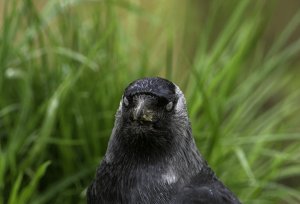Notice on Russia's Choucas, -Par G. Fischer.
Plate IM.
X armi the corneilles that flutter in quantity on Moscow during the winter, there is above all a species which attracted my attention ', it is a corneille with scapular or collar, or with lateral ribbon, but which is distinguished from Those that other naturalists have observed. Levaillant (V. Birds of Africa, Torn. II. Pag. I4. Pi- 53) described and represented a corneille which is very opposed to the Cap de Bonne-Espérance; It is found in Senegal according to the assertion of Buffon which calls it Corneille du Senegal. Cape Town calls him Bonte-Kraai, a speckled crow, because its plumage is regularly marked with black and white. In this species, white forms a necklace which in front extends to the bottom of the sternum and kisses only the neck from behind, the tail is rounded, the eyes are brown-black; The beak, feet and nails are black. Russia's collar corneille, which we will call the sômmerring corneille, in honor of the great anatomist and physiologist of this name, is smaller than choucas, with which he undoubtedly keeps the greatest analogy by his form and by his kind of life. Its length from the tip of the beak to that of the tail has not entirely twelve inches, and to that of the eleven-inch three-line nails. His beak is strong and pointed and has, at the forefront, a slight incision which makes it serrated. He has fourteen long lines from his end to the corners of the mouth, and two inches five lines the head included. Its tail has four inches two lines; his foot four inches five lines; The leg two inches five lines, tarsus a thumb five lines; The middle finger an inch two lines; The laterals are a short one, and the posterior has a thumb in length, but the nail longer and stronger than the others. He has a seven -fed foot. The top of the head is black from Velour changing to purple. The occiput and the upper part of the neck is ash gray as in ordinary choucas, but the sides of the neck are surrounded by a large white ribbon which is lost from behind in a grayish cap. The back, the croupion, the covers above the wings and the tail are a shiny black pulling very little on purple. The neck it belly are of a grayish or even black black out of gray. The large feathers of the wing, the feathers of the tail are lighter down, pulling on green. The third penne of the wing is the longest; Those of the tail, twelve, are rounded and of an almost equal length. The two intermediaries are however longer. The iris is whitish sometimes passing through furniture. Bee, feet and nails are black. They stay in winter and summer in these regions, but they enter the city in greater quantity during the winter. They nest like ordinary choucas in the highest towers, even sometimes in the low houses of the peasants. They lay four eggs. Although the choucas of Russia that I have just described, has a lot of relation to the choucas proper, it is however constantly decorated with this white spot, or of this white ribbon on both sides, which sometimes forms a whole necklace as in the Choucas living in Switzerland. He is constantly smaller. This constant decoration, and its greatness make me persist in my opinion to consider the choucas of Russia as a different species of common choucas, Connis Monedula F L., and to which the collar species of Switzerland appears. It can be recognized by the following sentence:
Corvus soemmerringii, Niger, Rostro Apice Dentato, Incano f collo fascia laterali alba.
As synonyms of variety belong to him:
Monedula Torquata. Charlet. Exercise. p. 75. Ne. 7. Onomasticon. p. 68. N °. 7.
Monedula Altéra. AIDROVANDI AVES. Tom. I. p. 775.
Alud Monedula? Genus. Jonston, Aves p. 26 T. XVI.
Helvetian Daw of English.
Collar choucas. Brisson, Ornithol Tom, Il p. 27.






